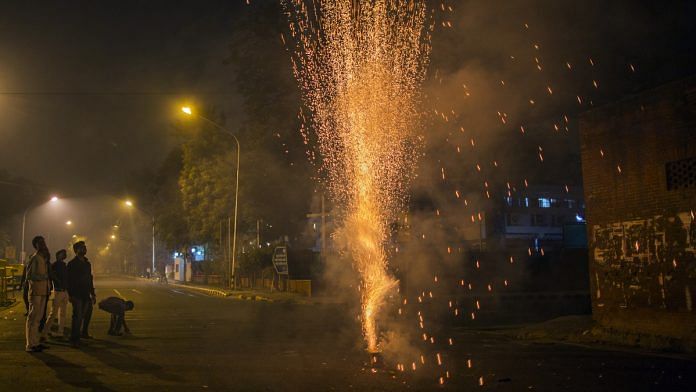Unless Delhi’s pollution crisis gains political traction, the Supreme Court will be drawn further into the fire.
On Tuesday, the permissibility of firecrackers again reached the doors of the Supreme Court. The script has become an increasingly familiar one. Delhi’s year-long pollution crisis grows worse in the months of October and November, and the judiciary intervenes to limit the use of firecrackers during the festival of Diwali. This intervention hopes to mitigate the pollution crisis in some small but tangible way.
The origins of the present case lie in October 2015, when the court was approached on behalf of infants seeking a range of remedies to tackle pollution levels. Orders passed in 2016 and 2017, relying on the Explosives Act, 1884, and the rules framed thereunder, approached the matter in several ways, from an outright ban on firecrackers to a “graded and balanced approach”. The court considered the place of temporary and permanent license holders, the locations for sale and use of firecrackers, the ingredients employed in the making of firecrackers, and so forth.
Also read: Is partial firecracker ban enforceable to fix Delhi air or will it fail like last Diwali?
A similar set of factors shaped Tuesday’s decision. On one hand, the petitioners contended that bursting of crackers during the Diwali period had a substantial impact on pollution levels, and thereby on public health. The respondents – who were manufacturers and traders of firecrackers – challenged this empirical claim. There was insufficient data, they argued, for claiming that bursting of crackers during Diwali impacted pollution levels in any major way. In the absence of such data, they argued that their right to the freedom of trade under Article 19(1)(g) of the Constitution could not be taken away.
The court’s perusal of the data led it to conclude that “air quality had worsened during Diwali”. “There were”, it observed, “more patients with symptoms of eye, increased coughing and patients with high metal levels in urine”. The court subsequently framed the question before it in the following terms: Should firecracker use/sale be restricted merely because it was not the sole cause behind the air pollution? The data before the court was limited, but it held it to be sufficient to limit firecracker use/sale. This is because, the court noted, environmental law relies on the “precautionary principle”, which “does not need exact studies/material”. “The very word ‘precautionary’”, it observed, “indicates that such a measure is taken by way of precaution, which can be resorted to even in the absence of definite studies”.
Also read: There’s a 50% rise in heart diseases in India. Blame salt, sugar and air pollution
In its eventual remedy, the court permitted the manufacture and sale of only a select class of firecrackers. Moreover, the sales involved could only be performed by licensed traders; the state was asked to spread awareness about the harms generated by firecracker usage; on Diwali, the use of firecrackers could only occur between 8 and 10 pm. This remedy, the court felt, enabled it to balance two competing rights: the right to a clean and healthy environment, which had been read as part of the right to life in Article 21, and the rights of the manufacturers and traders to carry on a trade of their choice under Article 19(1)(g).
The court’s approach was moderate, and the decision tries to strike a practical, meaningful note. It makes a genuine effort to offer a proportionate response to the problem at hand. Yet, the moment is one that should raise some degree of caution. The pollution crisis in Delhi is nothing short of an emergency, and the failure to respond to the matter in any serious, long-term way represents a genuine failure. Regardless of the varying technical assessments of how best to address this problem, the failure has above all been a political one – the unwillingness of different state and central governments to work together for a systemic solution, from which no single government will likely benefit during its days of power. This has been, in some sense, the great tragedy the pollution crisis exposes: our political vision has become so thin that we cannot even breathe.
In such a scenario, it is hardly surprising that the judiciary will step in. But if Tuesday’s order reveals anything, it reveals how difficult it is for courts to make any real intervention in such matters. The court simply does not have the range and the depth of data that the matter demands. In the absence of data, the court offered a half-hearted explanation for nonetheless intervening, and it tried to balance all considerations without truly investigating any in serious depth, almost as if it realised that, in its circumstances, it is not really placed to act in favour or against anyone.
Also read: Long exposure to air pollution can slow down your brain’s functioning, says new study
This is all well and good. One might feel that the positive impact will be limited, and the adverse consequences will be equally limited. But the question at hand is only likely to be further judicialised, and the cause will be the political vacuum that exists. The court will be unlikely to provide the solution we need. The greater the intervention it makes, the more likely it will be a matter that hasn’t been addressed in the thoroughgoing fashion it merits.
Unless the pollution crisis gains political traction, the court will be drawn further into the fire. It is far from clear, however, whether it can reduce the smoke.
Madhav Khosla, co-editor of the Oxford Handbook of the Indian Constitution, is a junior fellow at the Harvard Society of Fellows.



